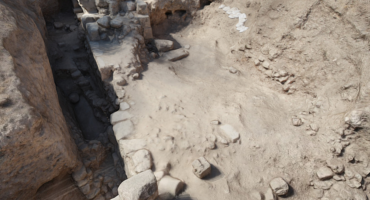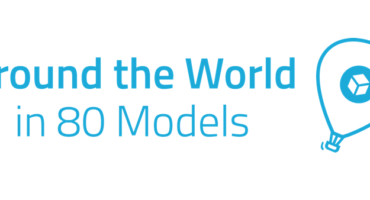Hop on board as we continue our journey Around the World in 80 Models! We began our itinerary at Sketchfab headquarters in New York and are working our way through Europe, Africa, Asia, Oceania, South America, and North America. To catch up on past destinations, check out the rest of the Around the World in 80 Models series.
This week we head to Syria, where Loïc Hussenet of Drones Imaging tells us how his group used multiple image sources to reconstruct Palmyra Castle.
Palmyra, Syria: Palmyra Castle
Drones Imaging is a French society created in 2013 and situated near Paris at Maisons Laffitte. Headed by Loïc Hussenet, it is an office specializing in photogrammetry, 3D modeling, and geomatics. Utilizing aerial images obtained by the civil drone industry, and as a member of the Palmyra 2.0 community, we share our model of Palmyra Castle.
Fakhr-al-Din al-Ma’ani Castle or Palmyra Castle is a castle in the province of Homs, Syria. The castle is thought to have been built by the Mamluks in the 13th century on a high hill overlooking the historic site of Palmyra, and is named for the Druze emir Fakhr-al-Din II, who extended the Druze domains to the region of Palmyra during the 16th century. The site of the castle and Palmyra in 1980 became a UNESCO World Heritage Site in recognition of the monumental ruins of a great city, which was one of the most important cultural centres of the ancient world.
To realize this model, Drones Imaging used many sources of aerial images available on the internet, with the majority of shots taken by M. Gérard Pouillot from a paraglider. For the rather complex sites that are equally inaccessible, such as Syria in June 2015 or Kathmandu in April 2015, it is generally in this way that the group proceeds to find the indispensable raw material for 3D modeling.
Open source: Youtube, Vimeo, Facebook and all the other social networks are veritable troves of images made available to internet users. Starting from these, the work of 3D modeling the fort of Palmyra consisted of first collecting the available digital data set and classifying it all by quality and in chronological order.
Since then, the first modeling was tested with Agisoft PhotoScan, which is perfectly adapted to 3D modeling from different merged sources, such as cameras, camcorders, or even scanned silver photographs. Unfortunately, the quality of the initial results was judged unsatisfactory and we proceeded with some adjustments to accentuate the level of detail on some places of the fort. It is this delicate second stage that needs particular attention: finding images with specific angles of view to locally increase the reconstruction quality of the site of Palmyra.
Following numerous tests aimed at conserving or eliminating certain photographs, we were finally able to export an optimal 3D rendering of the fort of Palmyra. Thanks to this method, we are happy to have contributed to the protection of the cultural patrimony of Palmyra from our offices in France, without having to go to Syria.
To see more of Drones Imaging’s models here on Sketchfab, check out their profile!



